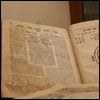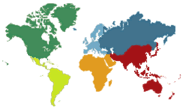When a parent in Natick, Mass., called Rabbi Levi Fogelman last week about a swastika daubed on the Boden Lane Bridge—just down the street from Chabad of Natick, which Fogelman directs—the rabbi resolved to turn the incident around. Chabad was planning an intimate community affair on Sunday, April 23, to mark the conclusion of the 42nd study cycle of Mishneh Torah, Maimonides’ 14-volume compendium distilling Jewish law from the Talmud and Midrash into a clear and authoritative code. Instead, Fogelman decided, celebration would become a community-wide event, an opportunity to educate and combat antisemitism with positivity.
The event, billed “Confidence in Our Community: Celebrating Peace Through the Teachings of Maimonides,” drew several hundred people, including the police chief and members of the town select board. Amid a heavy downpour, participants marched from Boden Lane Bridge to the Chabad center, gathering in the parking lot for the conclusion ceremony, or siyum in Hebrew.
The study program was launched by the Rebbe—Rabbi Menachem M. Schneerson, of righteous memory—in 1984. Recognizing that not everyone has the ability to study three chapters a day in time to complete the 14 books of Mishneh Torah in one year, the Rebbe created two additional parallel tracks: one that completes the study in three years by learning one chapter a day and another that goes through Maimonides’ compilation of Sefer HaMitzvot (“Book of Commandments”) over the period of a year.
This year marks a “triple celebration” that includes those who learned three chapters per day, those who learned one chapter a day, and those who follow the daily learning cycle of Sefer HaMitzvot, all simultaneously completing their study cycles, and related celebrations took place around the world.
Maimonides’ final chapter ends with a vision of peace, explained Fogelman to the attendees, many of whom came to show solidarity with the Jewish community. “In that era, there will be neither famine or war, envy or competition for good will flow in abundance,” writes Maimonides, the 12th-century sage and physician, about the Messianic era of universal peace. Why, Fogelman asked the audience, did Maimonides include a vision of the future in a book of laws?

“We live in an era where we see negativity,” Fogelman explained. “Maimonides was a realist. He experienced that, too. But we have to have a vision for the future; we have a responsibility to work towards that future vision.”
The book begins with discussing G‑d’s very existence, before proceeding to rule on all matters of practical Jewish tradition. “There’s lots of wisdom,” Fogelman said, “but a prerequisite is recognizing the Creator.”
Celebrations Held Worldwide
In El Paso, Texas, community members joined a siyum at Chabad-Lubavitch of El Paso, where 100 people had spent the past year studying Maimonides’ Sefer Hamitzvot, a shorter study cycle that covers all 613 mitzvahs. Rabbi Levi Greenberg sent subscribers a daily mitzvah video class or podcast, titled “Project 613.”

Across the Atlantic, the South African community held a siyum celebration at the DP World Wanderers Stadium. The scaled-up annual event was in honor of the Hakhel year, “the year of Jewish gathering” which occurs every seven years. Mandy Yachad, a former cricketer and hockey player for South Africa’s national teams, now turned observant Jew, headlined the event at the same stadium in which he once played. Among lay leaders and rabbis, he was joined by Ukraine’s Rabbi Yechiel Shlomo Levitansky, co-director of Chabad of Sumy, who was there on behalf of his beleaguered community.
Celebrations held were in towns and cities in Israel, with thousands gathering for a completion ceremony in Tel Aviv and hundreds traveling to the Tiberias for an event at Maimonides’s gravesite.
In Jerusalem’s Shaarei Chesed neighborhood, it was standing-room only at the famed Kehal Chasidim synagogue at a ceremony led by Shaarei Chesed Mara D’Atra Rabbi Yehoshua Meir Rosenthal and the Tolner Rebbe of Jerusalem. While many in attendance had completed the study of Rambam many times, it was an especially moving ceremony for those who had completed study for the first time.

Grand Completion Celebration on Lag BaOmer
In honor of the fact that this is a Hakhel year, a grand completion ceremony will take place outside Chabad-Lubavitch World Headquarters in Brooklyn, N.Y., on Lag BaOmer, which this year falls on the evening of Monday, May 8, and Tuesday, May 9. There, children will celebrate studying the final mitzvah of the Sefer HaMitzvot and together begin the opening words for the next year’s cycle.
In a 1985 Lag BaOmer address, the Rebbe explained that, in fact, Mishneh Torah begins with the basic commandment to “know that there is a First Being,” and at the end of his work, he concludes: “… they will know the things that are now concealed ... and will attain an understanding of their Creator to the utmost capacity of the human mind.”
However, continued the Rebbe, the entire work of Jewish law that lies between these two more esoteric lines isn’t another subject dealing with the practical, down-to-earth rules and regulations that govern Jewish life, but the practical expression of “knowing G‑d.” Knowledge of G‑d, taught the Rebbe, “… reaches maturity only after learning through Mishneh Torah. Then, at the conclusion, you truly come to know G‑d!”
There is no separation between the esoteric parts of Torah and the practical application of the Torah’s laws, the Rebbe continued, for “… they unite, for ‘the ‘word of the L‑rd’ means Halachah’ which unites all aspects of the Rambam. For the Halachah reveals the word of G‑d and the will of G‑d, and thus the knowledge of G‑d is revealed.”
Comprehensive resources for the daily study program can be found on Chabad.org here.








Start a Discussion